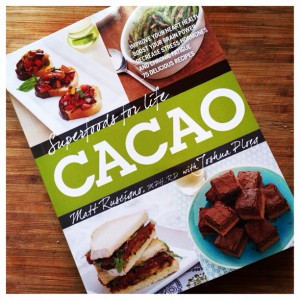- Like
- Digg
- Tumblr
- VKontakte
- Buffer
- Love This
- Odnoklassniki
- Meneame
- Blogger
- Amazon
- Yahoo Mail
- Gmail
- AOL
- Newsvine
- HackerNews
- Evernote
- MySpace
- Mail.ru
- Viadeo
- Line
- Comments
- SMS
- Viber
- Telegram
- Subscribe
- Facebook Messenger
- Kakao
- LiveJournal
- Yammer
- Edgar
- Fintel
- Mix
- Instapaper
- Copy Link
Chocolate is one of life’s great gifts. We give it as presents to show loved ones our affection, make cakes out of it to celebrate special events, and overindulge in it during holidays. And while we view it as a guilt-ridden pleasure, chocolate is actually good for us!
According to plant-based dietitian Matt Ruscigno, author of the new book Superfoods for Life, Cacao, cacao (the bean from which chocolate is made) is high in antioxidants and an excellent source of magnesium, iron, chromium, manganese, zinc, copper, omega-6 fatty acids, and heart-healthy oleic acids. “It sounds too good to be true, but it isn’t. I used over 60 peer-reviewed studies in writing this; so despite my own skepticism about ‘super foods,’ I’m confident about 100% of the content. Cacao, considered a ‘food of the gods,’ will boost your mood, improve cognition, and help lessen stress!”
Superfoods for Life, Cacao features six chapters on the health benefits of cacao and chocolate, and boasts 75 recipes for sweet and savory cacao recipes—from mains to desserts—including Tamarind Chocolate Chili, Huitlacoche-Chocolate Empanadas, Cocoa Buffalo Tempura Vegetables, Dolmathes with Currant-Chocolate Rice and Cacao Tzatziki. Hungry? We are too. But before we dive into chocolate bliss, Matt answers a few questions about how this divine book came to be:
Q: What’s your vegan story? How did you become vegan, a dietitian, and an athlete?
A: I went vegan when I was just 17 years old in 1996 – due to the influence of punk rock music. I decided shortly after to get a nutrition degree and become a registered dietitian! Athleticism was a slow progression that started with riding my bike cross country after graduation.
Q: How did you decide to write about superfoods, and why did you choose cacao specifically?
A: After co-authoring No Meat Athlete with Matt Frazier, Fairwinds Press asked me to write a book in their “Superfood for Life” series. I’m not that into “superfoods” per se, but when they said cacao I couldn’t pass it up because there’s so much research! Plus I knew my friend and cooking aficionado Joshua Ploeg would contribute incredible recipes.
Q: You’re a plant-based endurance athlete. How does cacao support athletic performance?
A: Cacao is high in phytochemicals which may help increase blood flow and also help in recovery. Plus, it’s high in magnesium and iron, two minerals athletes need.
Q: What’s one amazing piece of trivia or history about cacao that surprised you that you want to share?
A: There’s an idea in the research world right now that Alzheimer’s functions like Type 3 Diabetes. We know very little about its development, but cacao and other polyphenol foods are at the forefront of the research.
Q: What’s your favorite recipe in the book and why?
A: I love the Borscht and the Jerk Tofu! Joshua Ploeg is a culinary genius. I’ve been telling clients through my private practice that dark chocolate is actually good for you so it’s great to have these plant-based recipes for them to utilize.
Raw Chocolate Carrot Cake
8 servings
This creative dish combines the healthy fats found in raw cacao and cashews with the fat-soluble beta-carotene from carrots. Raisins supply much of the sweetness, and coconut and banana make this healthy delight more dessert-like.
Ingredients:
For the cake:
- ½ cup (55 g) grated apple, with a little salt and lemon juice on it
- 1 cup (110 g) grated carrot
- ½ cup (42.5 g) dried coconut flakes
- 1 cup (145 g) chopped cashews
- ½ teaspoon sea salt
- ½ cup (75 g) golden raisins
- 2 to 3 tablespoons (42 to 63 g) agave nectar or other sweetener
- ½ cup (48 g) raw cacao powder
- ½ cup (112 g) mashed banana
- 1 teaspoon ground ginger
- 1 teaspoon ground cinnamon
- ¼ teaspoon ground cloves
For the frosting:
- ½ cup (112 g) mashed banana
- 2 to 3 tablespoons (22 to 33 g) coconut powder
- 1 tablespoon (6 g) cacao powder
- 1 tablespoon (21 g) agave nectar or other sweetener (optional)
- 1 tablespoon (15 ml) lemon juice
- ¼ teaspoon salt
- ¼ teaspoon powdered mustard
Directions:
To make the cake:
Grind all the cake ingredients in a food processor and divide among 8 ramekins (the serving size is a little more than ½ cup). If you prefer bigger chunks of everything for a better personality, then leave the texture intact and mix by hand rather than grinding together in the food processor—your choice!
To make the frosting:
Blend all the ingredients and adjust seasonings to taste. Frost the cakes and chill before serving.

